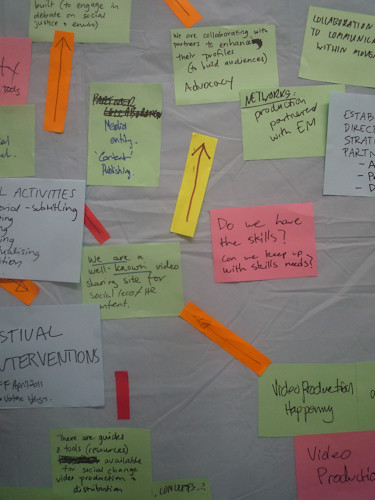
I’ve just finished co-authoring a book about measuring the Networked Nonprofit with colleague, KD Paine. One of the concepts that we wrestled with was “Social Media ROI,” I don’t think it necessarily works for nonprofits, especially when it applied as a litmus test to see if there are financial outcomes — cost reductions or increased revenue. Nonprofits should focus on continuum of value that incorporates both tangible and intangible benefits to integrating social media in communications or program goals. Of course, the ultimate result is social change or social impact.
Don’t get me wrong, I believe that for social media to be effective it must be aligned with organization’s program and communications objectives. For nonprofits, those are not solely money or efficiency for everything that could be measured. By aligning social media to organizational objectives and using measurement, you can answer the question: of all the ways we could be investing our resources, is social media the best choice to see the social change results that we want to see?
ROI is as an acronym for a business term, Return on Investment. It was created in the 1920s as a financial measure developed by DuPont and used by Alfred Sloan to make General Motors manageable. It is a flow chart that calculates business performance taking into account not only whether the company had a profit, but whether that profit was good enough relative to the assets it took to generate it. Over those 90 years, the chart has been polished, refined and so deeply embedded in business thinking that Wall Street views it as the only legitimate means of measuring business performance.
Should we be using an industrial measurement model in a digitally networked age? Should nonprofits use a narrow ROI definition in their quest to improve program results? Why not apply a “Theory of Change” method?
Why Use A Theory of Change
As David Hunter asks and answers this question in his essay on how nonprofits can use a theory of change in Leap of Reason by Mario Morino. How can nonprofits walk the line in measurement between unsupportable optimistic claims and mind-numbing “over-measurement.?” He suggests that way organizations can do this is to have robust theories of change that serve as blueprints for achieving specific results in well-defined domains.
A theory of change is a specific and measurable description of a social change initiative that forms the basis for strategic planning, on-going decision-making and evaluation. It defines all the results required to bring about a given long-term goal. A theory of change lays out the results and preconditions on a visual map that lays out the pathway for social change.
How It Works
In its simplest form, A Theory of Change consists of a series of “so then” statements that guide the design and management of an organization and its programs to achieve socially meaningful outcomes. It requires stakeholders to articulate underlying assumptions which can be tested and measured, and it also charts an incremental path towards results.
In their paper, “You Can Get There From Here,” James Connell and Adema Klem define a theory of change is simply a description of the why and how a program or initiative works. A Theory of Change should be:
- Plausible (stakeholders believe the logic of the model is correct: if we do these things, we will get the results we want and expect);
- Doable (human, political and economic resources are seen as sufficient to implement the action strategies in the theory);
- Testable (stakeholders believe there are credible ways to discover whether the results are as predicted);
- Meaningful (stakeholders see the outcomes as important and the magnitude of change in these outcomes being pursued as worth the effort).
Integrating Social Media Measurement With Your Theory of Change
It begins with a “To what End?” discussion on your team that leads to the articulation of SMART objectives – with a clear chain of “so that” statements. The intent is to get past simply saying “we’re going to get 1000 fans on Facebook.” That might one early step along the journey.
If you keep asking to “what end?” and then layout the continuum of results, you can see the road ahead. You can’t prove cause and effect, but you begin to see how to move along the path.
One of the problems I see is that social media is often seen as this “separate” thing – relegated to the intern or part-timer who works in isolation – the efforts are not aligned and connection with larger organizational goals. Perhaps using a Theory of Change model can help with alignment beyond tactics or financial results.
What you think? Does your organization use a “Theory of Change?” that identifies precisely how and where social media fits in? I’d love to hear about it in the comments. If you want to receive a notification about when the book is published, please sign up here.

Leave a Reply